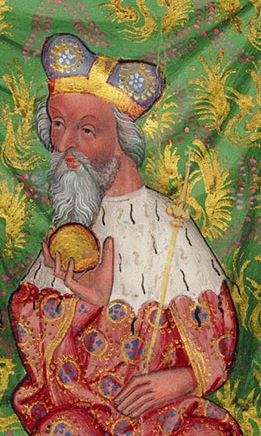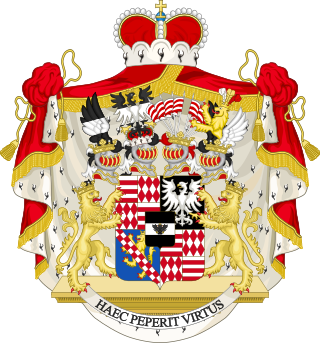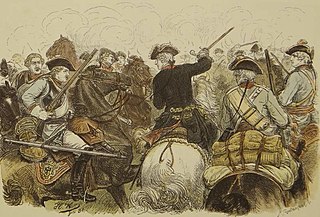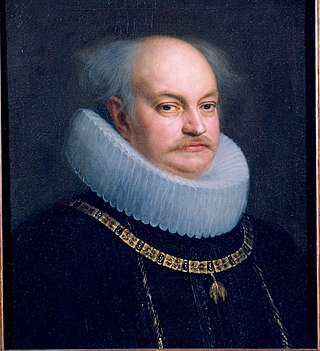
The House of Habsburg, also known as the House of Austria, is one of the most prominent and important dynasties in European history.

Jobst of Moravia, a member of the House of Luxembourg, was Margrave of Moravia from 1375, Duke of Luxembourg and Elector of Brandenburg from 1388 as well as elected King of Germany from 1410 until his death. Jobst was an ambitious and versatile ruler, who in the early 15th century dominated the ongoing struggles within the Luxembourg dynasty and around the German throne.

Reuss was the name of several historical states located in present-day Thuringia, Germany. Several lordships of the Holy Roman Empire which arose after 1300 and became Imperial Counties from 1673 and Imperial Principalities in the late 18th century were ruled by the House of Reuss.

The Czech lands or the Bohemian lands is a historical-geographical term that, in a historical context, refers the three historical regions of Bohemia, Moravia, and Czech Silesia together before Czechoslovakia and later the Czech Republic were formed. Together the three have formed the Czech part of Czechoslovakia since 1918 and the Czech Republic since 1 January 1993.

The Duchy of Bohemia, also later referred to in English as the Czech Duchy, was a monarchy and a principality of the Holy Roman Empire in Central Europe during the Early and High Middle Ages. It was formed around 870 by Czechs as part of the Great Moravian realm. Bohemia separated from disintegrating Great Moravia after Duke Spytihněv swore fealty to the East Frankish king Arnulf in 895.

Ezzelino III da Romano was an Italian feudal lord, a member of the Ezzelini family, in the March of Treviso. He was a close ally of the emperor Frederick II, and ruled Verona, Vicenza and Padua for almost two decades. He became infamous as a cruel tyrant, and was, in fact, the most "notorious" of the "early tyrants".

The House of Colloredo-Mansfeld is an originally Italian noble family of which a branch came to Austria in the late 16th century. There they were raised to barons in 1588, imperial counts in 1727 and imperial princes in 1763. They obtained Opočno Castle in the Kingdom of Bohemia in 1634 and acquired numerous further estates in Bohemia and Austria. In 1945 they were expropriated and expelled from the Czechoslovak Republic, but returned after 1990 and had parts of their former estates restituted.

The House of Liechtenstein, from which the principality takes its name, is the family which reigns by hereditary right over the principality of Liechtenstein. Only dynastic members of the family are eligible to inherit the throne. The dynasty's membership, rights and responsibilities are defined by a law of the family, which is enforced by the reigning prince and may be altered by vote among the family's dynasts, but which may not be altered by the Government or Parliament of Liechtenstein.

The Prince-Bishopric of Trent was an ecclesiastical principality roughly corresponding to the present-day Northern Italian autonomous province of Trentino. It was created in 1027 and existed until 1802, when it was secularised and absorbed into the County of Tyrol held by the House of Habsburg. Trent was a Hochstift, an Imperial State under the authority of a prince-bishop at Trento.

The Kingdom of Italy, also called Imperial Italy, was one of the constituent kingdoms of the Holy Roman Empire, along with the kingdoms of Germany, Bohemia, and Burgundy. It originally comprised large parts of northern and central Italy. Its original capital was Pavia until the 11th century.

Prince of Belmonte is a noble title created in 1619 by the Spanish crown for the Barons of Badolato and Belmonte. The name of the title is taken from the fortress town of Belmonte in Calabria, historically important for the defence of the Italian coast from Saracen invasion. Belmonte has been known since the Risorgimento as Belmonte Calabro.

Veveří is an originally ducal and royal castle in Brno in the Czech Republic. It is located about 12 kilometres (7 mi) northwest of Brno city centre on the Svratka River.

Susegana is a comune (municipality) in the Province of Treviso in the Italian region Veneto, located about 45 km (28 mi) north of Venice and about 20 km (12 mi) north of Treviso.

The First Silesian War was a war between Prussia and Austria that lasted from 1740 to 1742 and resulted in Prussia's seizing most of the region of Silesia from Austria. The war was fought mainly in Silesia, Moravia and Bohemia and formed one theatre of the wider War of the Austrian Succession. It was the first of three Silesian Wars fought between Frederick the Great's Prussia and Maria Theresa's Austria in the mid-18th century, all three of which ended in Prussian control of Silesia.

RamboldoXIII, Count of Collalto was an Italian Imperial commander.
Vilém II of Pernštejn was a Czech nobleman. He held the office of High Treasurer of Moravia from 1474 to 1487. He was High Marshall of Bohemia from 1483 to 1490 and Lord Chamberlain of Bohemia from 1490 to 1514.

The Castello San Salvatore is a castle in Susegana, in the Province of Treviso, Veneto, Italy. It was built in the 13th and 14th centuries, and is one of the largest castles in northern Italy.

Collalto is a village in the province of Treviso in northern Italy, forming a 'frazione' or part of the municipality of Susegana.

Blessed Giuliana of Collalto was an Italian Benedictine nun. She was beatified in 1743 by Pope Benedict XIV.

Alessandro I Pico della Mirandola was an Italian nobleman and military man, second Marquis of Concordia (1602–1637), second and last Prince of Mirandola (1602–




















